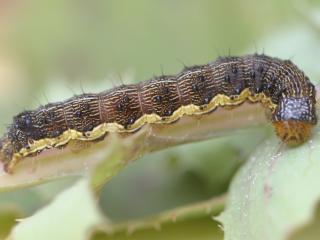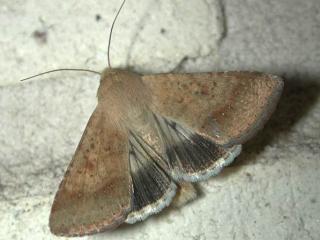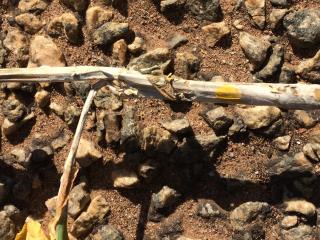Native budworm caterpillars may be increasing to damaging sizes in unsprayed crops
Caterpillar activity
- Pithara
- Ballidu
- Merredin
Agworld users have reported finding native budworm caterpillars in lupin crops near Pithara and Ballidu.
David Stead (Anasazi Agronomy) reports that a grower north-west of Merredin found 30-40 native budworm caterpillars (25-40mm long) in his early flowering lupins. These crops will be sprayed as soon as possible. Given the size of the caterpillars, these likely originated from the early flights of budworm during early July.
Although moth numbers being caught in surveillance traps have decreased in recent weeks, growers should be mindful of caterpillars increasing in size especially in unsprayed pulse and canola crops.
It takes about seven weeks from the egg stage to reach the fully-grown caterpillar stage of about 40mm long, given favourable temperatures. The last two growths stages (fifth and sixth instars, which are greater than 25mm in length) are responsible for eating over 90% of their total food consumption.
Native budworm moth trapping surveillance
- Usual automated and manual trapping locations
The higher budworm moth numbers reported this week by volunteer farmers, agronomists and DPIRD staff include; Wyalkatchem (57 moths), Cunderdin (47), Dowerin (33), Kellerberrin (31), Southern Cross (31), Varley (30), and Meckering (29)
A mapped view of the native budworm trap captures is available at cesar’s MothTrapVisWA page. For recent native budworm field reports refer to DPIRD’s PestFax map.
The economic spray threshold levels will vary with crop type, grain price and control cost; these can be calculated for each grower’s particular situation using a simple formula outlined in DPIRD’s Management and economic thresholds for Native Budworm page.
More information on native budworm can be found at DPIRD’s 2020 PestFax Issue 7 article Native budworm and other moths are active and PestFax Issue 10 article Native budworm update. Caterpillars are being found in cereals.
For more information contact Alan Lord, Technical Officer, South Perth +61 (0)8 9368 3758 or +61 (0)409 689 468.
Article author: Alan Lord (DPIRD South Perth).
Sclerotinia stem rot is being found in canola
- Regans Ford
- York
- Dale
David Cameron (Farmanco) has reported finding sclerotinia stem rot in a GT53 canola crop at Regans Ford. The plants were ranging from 10-50% bloom. It is in an area that retains moisture and was previously sown to canola in 2017. The grower has applied a fungicide.
David Peake (BASF) reports that this disease is also being seen in a canola variety trial at York. Sclerotinia infection is being seen in the varieties that have recently started flowering.
Plant pathologist Jean Galloway (DPIRD) reports that main stem infection has been found on Bonito canola on an early sown crop at Dale.
At Northam, sclerotia that formed in the 2018 season, and that have been exposed on the soil surface since early 2019, germinated last week. Sclerotia have also just started to germinate and produce apothecia at depots located at; the Geraldton DPIRD research annex (Woorree), Woodanilling and Gibson. This is a reminder to growers to consider the canola growing paddock history when assessing sclerotinia risk as sclerotia survive and produce apothecia for a number of seasons.
It is also important to consider the following factors to determine risk of sclerotinia; rainfall events before and after flowering, and current growth stage of canola. Based on the extensive research conducted by DPIRD over the last 10 years, a single foliar fungicide application at 30-50% bloom, should be considered if the paddock has a history of sclerotinia and conditions are favourable for infection before and during flowering. As stated on fungicide labels, fungicides should not be applied after 50% bloom due to withholding period concerns. A list of registered fungicides is available at DPIRD’s Registered foliar fungicides for canola in Western Australia page.
DPIRD’s free SclerotiniaCM app can be used to determine the potential yield benefit to applying fungicides to control sclerotinia. The app uses a forecasting model and the user can specify individual paddock data/history as well as recent and expected weather conditions so that the output relates to their own cropping circumstances. The SclerotiniaCM app can be downloaded from the App Store or Google Play Store onto your iPad or Android tablet. For more information refer to DPIRD’s SclerotiniaCM app page.
To read about previously reported information on sclerotinia management and sclerotinia activity this season refer to DPIRD’s 2020 PestFax Issue 8 article Sclerotinia apothecia are being found and 2020 PestFax Issue 11 article Sclerotinia apothecia found in lupins .
Further information can be found at the department’s Managing sclerotinia stem rot in canola page and GRDC’s Sclerotinia stem rot in canola fact sheet.
For more information on sclerotinia contact Plant pathologists Ciara Beard, Geraldton on +61 (0)8 9956 8504 or Andrea Hills, Esperance on +61 (0)8 9083 1144.
Article authors: Ciara Beard (DPIRD Geraldton), Jean Galloway (DPIRD Northam) and Andrea Hills (DPIRD Esperance).



